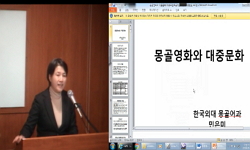중국역사에서 10세기~13세기는 ‘송・원 온난기’로 이해할 수 있다. 대용자료(proxy-data)를 근거로 한 자연과학적 연구결과에 따르면, 13세기 온난기 동안 기후는 대체로 온난습윤했다. 문헌기...
http://chineseinput.net/에서 pinyin(병음)방식으로 중국어를 변환할 수 있습니다.
변환된 중국어를 복사하여 사용하시면 됩니다.
- 中文 을 입력하시려면 zhongwen을 입력하시고 space를누르시면됩니다.
- 北京 을 입력하시려면 beijing을 입력하시고 space를 누르시면 됩니다.
부가정보
국문 초록 (Abstract)
태평양 여름몬순의 영향을 많이 받는 중국은 지난 1800년 동안 대체로 온난기에는 습윤했고 한랭기에는 건조한 기후 패턴을 보였다. 문헌기록 상으로도 한랭기였던 12세기 중반 이후 특히, 1180년대~1190년대에 기근이 폭증했다. 그러다가 온난기가 진행된 13세기에 들어서면서 기근이 현저히 감소하였으나, 1260년대부터 화북지역에서 기근이 급격히 증가하고 뒤를 따라 회수 이남 지역에서도 기근이 급격히 증가하는 추세를 보인다.
13세기 전반기의 온난습윤한 기후는 몽골이 서정(西征)을 진행하는 데 유리한 조건을 제공했다. 그리고 1260년대 후반 이후 기온이 하강하면서 찾아온 초원지역의 조드(Jud) 현상과 화북 지방의 기근 증가는 쿠빌라이에게 더 많은 영지와 잉여생산물의 확보를 위한 정치・군사적 행동을 추동하는 여러 요인 중 하나가 되었을 것이다.
중국역사에서 10세기~13세기는 ‘송・원 온난기’로 이해할 수 있다. 대용자료(proxy-data)를 근거로 한 자연과학적 연구결과에 따르면, 13세기 온난기 동안 기후는 대체로 온난습윤했다. 문헌기록 상으로 볼 때, 12세기는 분명 한랭기였던 것으로 보인다. 13세기로 접어들면서 이상 온난 기후 기록이 눈에 띄게 증가하고 있다. 회수 이남지역(A지역)과 특히 D지역(장소 특정이 어려운 기사)에서 그러하다. 회수・진령산맥 이북지역~장성 이남 지역(B지역)은 11세기~13세기 동안 이상 한랭기후가 꾸준히 등장한다. 이 지역은 간헐적 혹한이 존재했을 가능성이 있다. 13세기 후반기에 대체로 장성 이북지역(C지역) 등 북쪽지역에서 한랭화가 조금 더 강하게 나타나고 회수 이남에서는 약한 것으로 보아 본격적인 한랭기로 접어들었다기보다는 온난기에서 한랭기로 넘어가는 전환기로 해석할 수 있겠다.
태평양 여름몬순의 영향을 많이 받는 중국은 지난 1800년 동안 대체로 온난기에는 습윤했고 한랭기에는 건조한 기후 패턴을 보였다. 문헌기록 상으로도 한랭기였던 12세기 중반 이후 특히, 1180년대~1190년대에 기근이 폭증했다. 그러다가 온난기가 진행된 13세기에 들어서면서 기근이 현저히 감소하였으나, 1260년대부터 화북지역에서 기근이 급격히 증가하고 뒤를 따라 회수 이남 지역에서도 기근이 급격히 증가하는 추세를 보인다.
13세기 전반기의 온난습윤한 기후는 몽골이 서정(西征)을 진행하는 데 유리한 조건을 제공했다. 그리고 1260년대 후반 이후 기온이 하강하면서 찾아온 초원지역의 조드(Jud) 현상과 화북 지방의 기근 증가는 쿠빌라이에게 더 많은 영지와 잉여생산물의 확보를 위한 정치・군사적 행동을 추동하는 여러 요인 중 하나가 되었을 것이다.
다국어 초록 (Multilingual Abstract)
China is under heavy influence of Summer Monsoon of the Pacific, and as a result, in the past 1,800 years, it experienced humid climate during the warm period and dry climate during the cold period. As shown in textual evidence which has this time as the cold period, famine happened much more frequently after the mid-twelfth century and especially between 1180s and 1190s. Famine drastically weakened in the thirteenth century as the warm period began; however, starting from the 1260s, famine broke out more rapidly first in the Huabei area and then in the South of Huai Shui.
The warm-humid climate of the early thirteenth-century favored the Mongol’s western campaign with better odds. Drop of temperature after the late 1260s brought the Jud phenomenon in the grasslands and increased the frequency of famine. These factors must have been one of many motivations that influenced Kublai to pursue more political and military actions to obtain more lands and surplus goods.
In history of China, the period between the tenth and thirteenth century is understood as the ‘warm period.’ Based on a research in the field of natural science, which utilized the proxy-data methodology, the climate during the ‘warm period’ o...
In history of China, the period between the tenth and thirteenth century is understood as the ‘warm period.’ Based on a research in the field of natural science, which utilized the proxy-data methodology, the climate during the ‘warm period’ of the thirteenth century was mostly warm-humid. Available textual evidence suggests that the twelfth century was indeed in the cold climate. Abnormal temperature appeared more frequently at the thresh hold of the thirteenth century. This trend is more apparent in Area A (South of Huai Shui) and Area D (Unidentifiable region based on available historical evidence). Frequent presence of cold climate is also observed in Area B (Qinling Mountains and the Huabei-South of the Great Wall) between the eleventh and thirteen century. It is possible that intermittent extreme cold climate was present in this area. Evidently the late thirteenth century can be identified as a transitional period, for then cold climate appeared more strongly in the northern area such as Area C (North of the Great Wall) whereas that in the the South of Huai Shui was weaker.
China is under heavy influence of Summer Monsoon of the Pacific, and as a result, in the past 1,800 years, it experienced humid climate during the warm period and dry climate during the cold period. As shown in textual evidence which has this time as the cold period, famine happened much more frequently after the mid-twelfth century and especially between 1180s and 1190s. Famine drastically weakened in the thirteenth century as the warm period began; however, starting from the 1260s, famine broke out more rapidly first in the Huabei area and then in the South of Huai Shui.
The warm-humid climate of the early thirteenth-century favored the Mongol’s western campaign with better odds. Drop of temperature after the late 1260s brought the Jud phenomenon in the grasslands and increased the frequency of famine. These factors must have been one of many motivations that influenced Kublai to pursue more political and military actions to obtain more lands and surplus goods.
동일학술지(권/호) 다른 논문
-
무인정권기 혐오 범죄 그리고 치안 - 13세기 고려의 온난 기후
- 한국생태환경사학회
- 정은정
- 2023
- KCI등재
-
- 한국생태환경사학회
- 오항녕
- 2023
- KCI등재
-
- 한국생태환경사학회
- 김문기
- 2023
- KCI등재
-
FGS's Humanistic Buddhism Activities to Making Good Environment and Mental Health
- 한국생태환경사학회
- 俞明仁
- 2023
- KCI등재





 KCI
KCI 스콜라
스콜라






